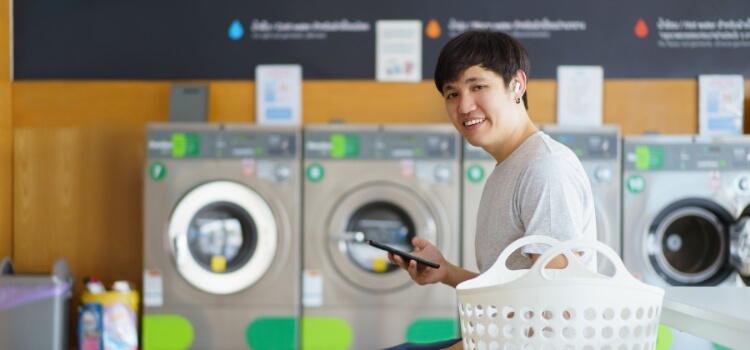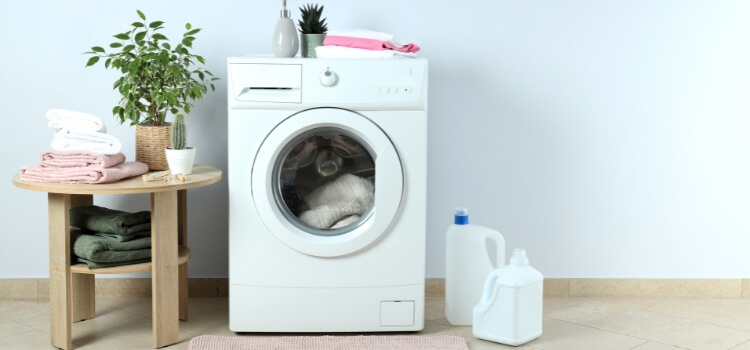As an Amazon Associate, I earn from qualifying purchases
A washing machine typically uses around 10 to 20 amps during its operation. This can vary based on the model.
Are you curious about the energy consumption of your washing machine? Understanding how many amps a washing machine uses can help you manage your electricity usage effectively. By knowing this information, you can make informed decisions to optimize energy efficiency in your home.
Let’s delve deeper into the power requirements of washing machines and how it impacts your overall energy consumption.

Introduction To Washing Machine Energy Use
Washing machines typically use around 10–15 amps during operation, depending on the model and cycle. Energy usage can vary greatly depending on the efficiency of the machine and the size of the load. It’s important to consider the energy consumption of your washing machine when trying to reduce your household’s overall energy usage.
The Importance Of Knowing Your Appliance’s Amps
Understanding your washing machine’s amperage is crucial for electrical safety.
Knowing the amps helps prevent overloading circuits and potential fire hazards.
Average Energy Consumption Of Household Washers
Most washing machines consume around 10 to 15 amps during operation.
Energy-efficient models use less power, saving money and reducing environmental impact.
Decoding The Electrical Specifications
A washing machine typically uses around 15 to 30 amps during its operation. It’s important to check the electrical specifications to ensure that your home’s circuitry can support the machine’s power requirements. Understanding the amp usage of your washing machine can help prevent electrical overloads and ensure safe operation.
Where To Find The Amp Rating On Your Washing Machine
Look for the amp rating on the manufacturer’s label inside the door or on the back of the washing machine.
Understanding The Power Label
The power label provides information on the voltage, current, and power consumption of your washing machine.
Factors Affecting Washing Machine Amperage
Impact Of Machine Size And Capacity
The size and capacity of a washing machine play a crucial role in determining its amperage. Larger machines with higher capacity generally require more power to operate, leading to higher amperage usage. When shopping for a washing machine, consider the size and capacity to gauge the potential amperage requirements.
Influence Of Washing Cycles And Settings
The specific washing cycles and settings chosen can also impact the amperage usage of a washing machine. For instance, heavy-duty cycles or high-speed spin settings may draw more current, resulting in increased amperage consumption. It’s important to be mindful of the selected cycles and settings to manage amperage usage efficiently.
Comparative Amperage: Traditional Vs. High-efficiency Models
Energy Consumption In Top-loading Versus Front-loading Washers
Top-loading washing machines typically use more water and energy than front-loading models. The agitator in top-loading machines requires more power to operate, leading to higher energy consumption. Conversely, front-loading washers use less water and energy due to their horizontal drum, which requires less power to rotate.
The Role Of Energy Star Ratings In Efficiency
Energy Star ratings play a crucial role in determining the efficiency of washing machines. Appliances with higher Energy Star ratings are designed to consume less energy, resulting in lower electricity bills and reduced environmental impact. By choosing an Energy Star-certified washing machine, consumers can make environmentally conscious decisions while saving on utility costs.

Calculating Electrical Costs
When it comes to managing household expenses, it’s crucial to have a clear understanding of the energy consumption of your appliances. For those wondering how to calculate the electrical costs associated with operating a washing machine, we’ve got you covered.
How To Estimate Your Washing Machine’s Energy Usage
Estimating your washing machine’s energy usage involves identifying the power consumption in terms of amps and voltage. You can find this information on the appliance’s label or in the user manual. Once you have these details, use the following formula:
(Amps x Voltage) = Watts
Tips For Reducing Your Electric Bill
Reducing your electric bill is possible with some simple adjustments. Consider the following tips:
- Use cold water for washing whenever possible to save energy.
- Opt for shorter wash cycles to minimize energy consumption.
- Ensure the washing machine is full before running a cycle to maximize efficiency.
Safety Considerations
When operating a washing machine, it’s crucial to consider the safety aspects, especially in terms of electrical requirements and safe operation. By understanding the amperage and following proper guidelines, you can prevent circuit overloads and ensure the safe use of your washing machine.
Electrical Requirements And Safe Operation
Understanding the electrical requirements of your washing machine is essential for safe operation. Washing machines typically require a dedicated circuit with a specific amperage. It’s important to consult the manufacturer’s guidelines or the appliance’s manual to determine the exact amperage requirement for your specific model.
Preventing Circuit Overloads With Proper Amperage Knowledge
Proper knowledge of the amperage requirements can help prevent circuit overloads. By ensuring that the electrical circuit can handle the amp draw of the washing machine, you can minimize the risk of overloading the circuit and potential electrical hazards. Always adhere to the recommended amperage and avoid using extension cords or sharing the circuit with other high-power appliances.
Maintenance Tips To Optimize Performance
To optimize washing machine performance, focus on regular maintenance. Check the amps usage of your washing machine to ensure efficiency. Follow the manufacturer’s guidelines for optimal performance and energy savings.
Regular Upkeep To Maintain Energy Efficiency
Regular maintenance of your washing machine is essential to ensure optimal performance and energy efficiency.
Recognizing Signs Of Excessive Power Consumption
Keep an eye out for unusual spikes in your electricity bill or if the machine is taking longer than usual to complete a cycle.
Future Trends In Washing Machine Efficiency
Discover the future of washing machine efficiency by exploring the electricity usage, measured in amps, required by modern appliances for optimal performance. Understanding the energy consumption of washing machines is crucial in adapting to eco-friendly and cost-effective solutions for laundry needs.
Innovations In Appliance Technology
Modern washing machines are incorporating advanced technologies to optimize energy consumption.
The Movement Towards Sustainable Home Appliances
Manufacturers are designing washing machines to be more eco-friendly and energy-efficient. As technology advances, washing machines are becoming more energy-efficient and environmentally friendly.
Innovations In Appliance Technology
New washing machines are equipped with sensors to adjust water levels and optimize energy usage.
The Movement Towards Sustainable Home Appliances
There is a growing demand for washing machines that consume less water and electricity to reduce environmental impact.
Frequently Asked Questions
Yes, a washing machine can typically run on a 15 amp circuit. Most washing machines require 15 amps to operate efficiently, ensuring they can be powered by a standard residential electrical circuit. However, it’s important to consult the manufacturer’s guidelines to confirm the specific requirements for your washing machine.
A washing machine typically pulls around 10-15 amps during operation. However, this may vary depending on the specific model and cycle being used. It is important to check the manufacturer’s specifications to determine the exact amperage of your washing machine.
Yes, a washing machine typically requires a 20 amp circuit to operate efficiently and safely.
A washing machine uses an average of 400 to 1300 watts of electricity per wash cycle, which equates to about 3 to 7 amps.
Yes, it is safe to run a washing machine on a 15-amp circuit. However, it may not be able to handle other electrical appliances running simultaneously.
Conclusion
Understanding the amperage of your washing machine is crucial for maintaining electrical safety and efficiency. By knowing the amperage requirements, you can ensure that your electrical system can handle the load. Additionally, choosing energy-efficient models can help reduce overall electricity consumption, benefiting both your wallet and the environment.
As an Amazon Associate, I earn from qualifying purchases
Leave a Reply